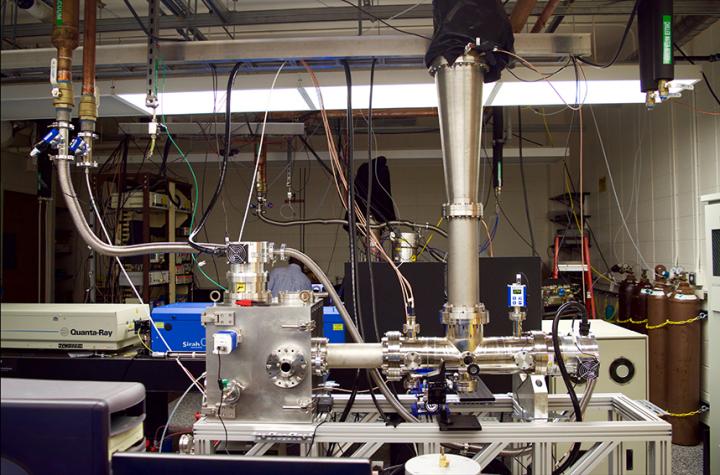A new view of microscopic interactions

A team of scientists led by Arthur Suits at the University of Missouri has developed a new experimental approach to study chemistry. Credit: University of Missouri
When two cars collide at an intersection — from opposite directions — the impact is much different than when two cars — traveling in the same direction — “bump” into each other.
In the laboratory, similar types of collisions can be made to occur between molecules to study chemistry at very low temperatures, or “cold collisions.”
A team of scientists led by Arthur Suits at the University of Missouri has developed a new experimental approach to study chemistry using these cold “same direction” molecular collisions. Suits said their approach hasn't been done before.
“When combined with the use of a laser that 'excites' the molecules, our approach produces specific 'hot' states of molecules, allowing us to study their individual properties and provide more accurate experimental theories,” said Suits, a Curators Distinguished Professor of Chemistry in the College of Arts and Science.
“This is a condition that does not occur naturally but allows for a better understanding of molecular interactions.
Suits equated their efforts to analyzing the results of a marathon race.
“If you only look at the average time it takes everyone to complete the Boston Marathon, then you don't really learn much detail about a runner's individual capabilities,” he said.
“By doing it this way we can look at the fastest 'runner,' the slowest 'runner,' and also see the range and different behaviors of individual 'runners,' or molecules in this case. Using lasers, we can also design the race to have a desired outcome, which shows we are gaining direct control of the chemistry.”
Suits said this is one of the first detailed approaches of its kind in this field.
“Chemistry is really about the collisions of molecules coming together and what causes chemical reactions to occur,” he said.
“Here, instead of crossing two beams of molecules with each other as researchers have often done before, we are now pointing both beams of molecules in the same direction. By also preparing the molecules in those beams to be in specific states, we can study collisions in extreme detail that happen very slowly, including close to absolute zero, which is the equivalent of the low temperature states needed for quantum computing.”
###
“State-to-state scattering of highly vibrationally excited NO at broadly tunable energies,” was published in Nature Chemistry. Other authors include Chandika Amarasinghe, Hongwei Li and Chatura A. Perera at MU; Matthieu Besemer, Ad van der Avoird and Gerrit C. Groenenboom at Radboud University in the Netherlands; Junxiang Zuo and Hua Guo at the University of New Mexico; Changjian Xie at the University of New Mexico and Northwest University in China; and Jacek K?os at the University of Maryland.
The research was supported by the U.S. Army Research Office, the U.S. Air Force Office of Scientific Research, the U.S. National Science Foundation, the Netherlands Organization for Scientific Research and the European Research Council under the European Union's Horizon 2020 Research and Innovation Program. The content is solely the responsibility of the authors and does not necessarily represent the official views of the funding agencies.
Media Contact
All latest news from the category: Life Sciences and Chemistry
Articles and reports from the Life Sciences and chemistry area deal with applied and basic research into modern biology, chemistry and human medicine.
Valuable information can be found on a range of life sciences fields including bacteriology, biochemistry, bionics, bioinformatics, biophysics, biotechnology, genetics, geobotany, human biology, marine biology, microbiology, molecular biology, cellular biology, zoology, bioinorganic chemistry, microchemistry and environmental chemistry.
Newest articles

First-of-its-kind study uses remote sensing to monitor plastic debris in rivers and lakes
Remote sensing creates a cost-effective solution to monitoring plastic pollution. A first-of-its-kind study from researchers at the University of Minnesota Twin Cities shows how remote sensing can help monitor and…

Laser-based artificial neuron mimics nerve cell functions at lightning speed
With a processing speed a billion times faster than nature, chip-based laser neuron could help advance AI tasks such as pattern recognition and sequence prediction. Researchers have developed a laser-based…

Optimising the processing of plastic waste
Just one look in the yellow bin reveals a colourful jumble of different types of plastic. However, the purer and more uniform plastic waste is, the easier it is to…



